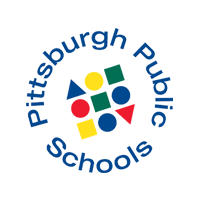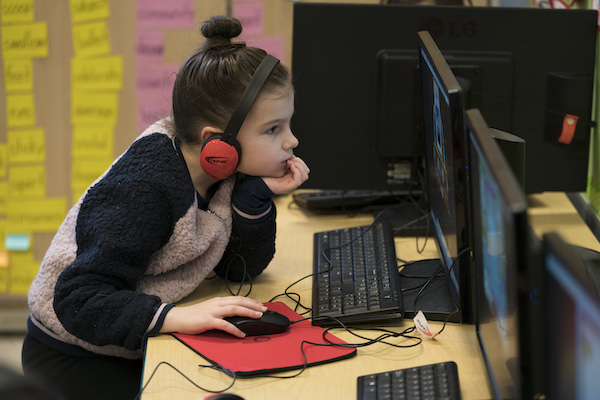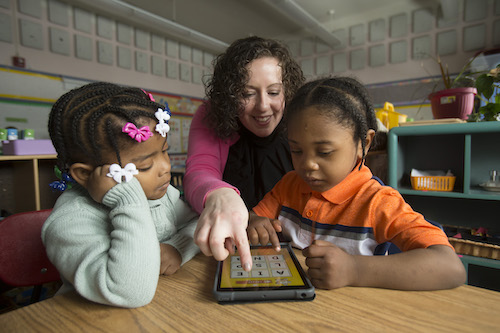Pittsburgh Public Schools: Great Expectations for Going Digital on Day One
Pittsburgh Public Schools joined 1EdTech as a Contributing Member in July 2016. Thanks to Ellen Botkin, coordinator of data systems integration, Scott Gutowski, chief information and technology officer, and Ebony Pugh, public information officer, for their contributions to this feature story.
Welcome to the
Pittsburgh Public Schools (PPS) where teachers enjoy increased access to digital resources without the added administrative burden of creating and maintaining student rosters. Spend a few minutes experiencing a school day in the life of "Mr. Pitt" a high school English teacher in the district.
 Maintaining Student Rosters with Ease
Maintaining Student Rosters with EaseMr. Pitt loves the number and variety of digital resources available to augment learning opportunities for his 150 students. He especially loves that today, as students join his class, their access to those digital tools is automatically handled for him by the Office of Information and Instructional Technology (OIT). This allows Mr. Pitt to focus on interacting with his students and helping each master the content of his English class. In the past, as students transitioned into or out of Mr. Pitt’s classes—something that often happens in a district the size of PPS—he had to wait until central office personnel made roster updates, which might take place once a week or as infrequently as once a month.
Another hassle that is a thing of the past for Mr. Pitt and his fellow teachers is having to update rosters manually. When manual adjustments were made, it meant that rosters didn’t always reconcile correctly after an update came from the central office. So, Mr. Pitt could end up with the same student rostered twice! Also in the past, OIT might have to upload 54 individual rosters because a particular software didn't support enterprise-level management of classes and users. However, today, rosters are automatically transferred to software companies daily. So, when a new student enters mid-week, mid-month, or mid-term, that student can use digital instructional materials the very next day.
Teachers like Mr. Pitt have come to expect “clean” rosters in all of their digital teaching and learning tools and applications. Because OIT has been able to solve this administrative burden, educators won’t tolerate waiting for enrollment or access to new resources. More importantly, teachers expect rosters to be accurate, reliable, and practically real-time in managing the transfer of students from class to class.
Digital Transformation and Innovation
So how did this digital transformation happen? PPS revolutionized their process for rostering students and allocating access to digital resources after joining
1EdTech Consortium, a non-profit membership collaborative run by leading districts, states, universities, and edtech suppliers. Through membership, PPS learned how other districts are transforming how every student has access to digital resources from the first moment he or she enters the classroom. With 1EdTech’s
OneRoster® standard, schools pave the way for innovative teaching and learning digital resources and eliminate problems with access to resources and the exchange of data before they happen. The standard supports the secure provisioning of students, teachers, and other authorized system users via the well-recognized security protocol, OAuth 2.0. Additional OneRoster services include the transmission of formative and summative score information and the ability to create associations between learning resources for a course and course sections.

Today, Pittsburgh has 42 integrations using OneRoster. Ellen Botkin, Coordinator of Data Systems Integration, says this milestone was met by moving away from custom integrations and individually created roster files. Botkin shares that by moving to this open standard for rostering, the district has been able to send consistent data to all vendors. Asked to calculate the savings because of this approach, she says, “Any time we don’t have to engage one of our developers to create a custom integration, it saves approximately $150 per hour plus additional staff time that would be needed to provide guidance to the developer and review the draft results. We estimate it takes us an additional five to eight hours per product over what we are able to do with OneRoster.”
Also, freeing up time previously spent on custom rostering means OIT can focus their attention on other ways to improve the experience of teachers.
One of the ways that OIT has been able to ramp up the number of applications using the 1EdTech OneRoster standard is by encouraging suppliers who make it work for some products to be able to make it work for all products.
Botkin shares that her team is working on developing a process to ensure OIT is getting engaged with other organizational divisions at the right time in the procurement process. This will confirm that potential vendors can meet the requirements so that teachers don’t end up with the burden of rostering students. The district is also working to establish and implement uniform contract language, spelling out their integration requirements.
Botkin shares, “By insisting that we use OneRoster, we can consistently hold our vendor partners to the same high standards.”
1EdTech provides a
number of resources to help districts develop contracts and RFP language. Best practices for procurement—designed by K-12 members representing over 11 million students—document suggested language requiring that suppliers adopt and stay up-to-date on their
1EdTech certification(s). 1EdTech certification is the process through which a product’s implementation of an 1EdTech standard is tested to meet rigorous requirements for plug-and-play interoperability. Pittsburgh has taken advantage of several of these resources and continues to review how they can implement others. The 1EdTech Product Directory (
imscert.org) is the official listing of products that have achieved 1EdTech conformance certification. 1EdTech certified products enable PPS to be confident that they are using the most cost-effective and secure way to achieve product integrations while being assured a given product is the best it can be in terms of open innovation well into the future.
Using OneRoster, Pittsburgh Public Schools saves approximately $150 per hour on an estimated 5-8 hours per product required for custom integrations.
Botkin observes that the process of improvement is cyclical. As the district improves its roster extracts, their suppliers are making improvements in the management of rostering at the enterprise level. In turn, this makes it possible for the district to improve its rostering process even further. Districts, vendors, and technology are getting more sophisticated, and everyone reaps the benefits.
Advice for Others
With so many integrations in such a short time, Botkin and her team have gained a great deal of knowledge to pass on to other K-12 institutions that want to start transforming their rostering strategies. She says, “First and foremost, the technology team must develop a relationship with the curriculum team. By cultivating regular and ongoing conversation, both divisions will be in a position to work through the steps toward becoming digital on day one.”
As in the case with Mr. Pitt, it doesn’t take long for teachers and leaders to have greater expectations for enrolling and maintaining student rosters. Once the curriculum team sees real-life examples of how using OneRoster protects teachers’ time, they will understand how high the cost is otherwise.

Botkin also notes the cost-benefit of adopting the OneRoster open standard. Anytime a custom integration doesn’t have to be factored in, or a developer doesn’t have to build extracts, is “money in the bank” for the district. The cost-saving discussion led to another value add—PPS getting smarter and savvier about how they are doing things. Botkin states, “There are great benefits to just going through the process like discovering what questions to ask up front the next time, and being able to reuse a roster or the querying logic used to build elements of the file in other situations.”
Leaning on the expertise of vendor partners has also been beneficial. Botkin’s team was able to walk through errors together with their vendor partners—a process that garnered valuable feedback for PPS.
Data cleanliness processes and protocols will help improve the integration experience. For instance, a hyphen or apostrophe may be considered a “special character” within a field (e.g., last name) by some vendors so engage stakeholders throughout the district in having a round table to come up with a solution that is going to work when such situations arise.
Future Plans
Over the next two to three years, the PPS curriculum team will lead a process of sunsetting applications that are no longer needed or have overlapping functionality.
The district also has plans to implement a consistent single sign-on portal for students and staff. They want to have a comprehensive “one stop shop” experience for users accessing applications. Botkin says the district is getting closer but not yet “there.” This functionality will save instructional and planning time since teachers and students will not have to remember how to get access to each application and won’t have to remember passwords. Botkin comments, “There are more important things for teachers and students to remember rather than having to keep up with how to get to applications!”
Conclusion
Botkin shares that teachers and administrators have come to expect the regularity of access and standardized data for products that are using the OneRoster format. Having instant access and reducing the administrative demands on teachers has been a big success for Pittsburgh Public Schools. Botkin states, “I wish all the products we use were OneRoster certified!”
Get the latest news and resources to help support the evolution to next generation digital learning.

 Today, Pittsburgh has 42 integrations using OneRoster. Ellen Botkin, Coordinator of Data Systems Integration, says this milestone was met by moving away from custom integrations and individually created roster files. Botkin shares that by moving to this open standard for rostering, the district has been able to send consistent data to all vendors. Asked to calculate the savings because of this approach, she says, “Any time we don’t have to engage one of our developers to create a custom integration, it saves approximately $150 per hour plus additional staff time that would be needed to provide guidance to the developer and review the draft results. We estimate it takes us an additional five to eight hours per product over what we are able to do with OneRoster.”
Today, Pittsburgh has 42 integrations using OneRoster. Ellen Botkin, Coordinator of Data Systems Integration, says this milestone was met by moving away from custom integrations and individually created roster files. Botkin shares that by moving to this open standard for rostering, the district has been able to send consistent data to all vendors. Asked to calculate the savings because of this approach, she says, “Any time we don’t have to engage one of our developers to create a custom integration, it saves approximately $150 per hour plus additional staff time that would be needed to provide guidance to the developer and review the draft results. We estimate it takes us an additional five to eight hours per product over what we are able to do with OneRoster.” Botkin also notes the cost-benefit of adopting the OneRoster open standard. Anytime a custom integration doesn’t have to be factored in, or a developer doesn’t have to build extracts, is “money in the bank” for the district. The cost-saving discussion led to another value add—PPS getting smarter and savvier about how they are doing things. Botkin states, “There are great benefits to just going through the process like discovering what questions to ask up front the next time, and being able to reuse a roster or the querying logic used to build elements of the file in other situations.”
Botkin also notes the cost-benefit of adopting the OneRoster open standard. Anytime a custom integration doesn’t have to be factored in, or a developer doesn’t have to build extracts, is “money in the bank” for the district. The cost-saving discussion led to another value add—PPS getting smarter and savvier about how they are doing things. Botkin states, “There are great benefits to just going through the process like discovering what questions to ask up front the next time, and being able to reuse a roster or the querying logic used to build elements of the file in other situations.”


